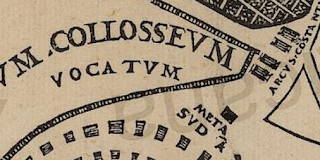This week's digitizations by Digita Vaticana put me in mind of that change, because one of them is of a book which is generally agreed to be an author's manuscript from 750 years ago: a commentary by the Dominican philosopher-theologian Thomas Aquinas. Vat. lat. 9851 has, as one might expect, lots of crossings out, as on folio 35v:
At the back is various by-play including a letter (typewritten in 1951 - the thin end of the wedge as hand-script began to recede) by the bishop of Salamanca.
Autographs of Aquinas are quite rare. There is a codex in Naples, and this book's shelf neighbour, Vat. lat 9850 containing Super Boethium De Trinitate (fol. 1–104) and Super Isaiam (fol. 105–114).
What is extraordinary is that there were people last century not only skilled enough to decipher this Latin cuneiform, but actually able to recognize one man's own handwriting into the bargain.
Maria Burger (publication), for example, published an article some years ago, arguing that Aquinas was the person who inscribed glosses in Cologne Cathedral Codex 30. In an age where handwriting is atrophying, for how much longer will people be able to make such an identification at a glance?
The full list of digitizations runs to 29, and brings the posted total before Easter to 3,987. Here's my unofficial list. You won't get it anywhere else: the Biblioteca does not publish any official list.
- Reg.lat.1, Vulgate Bible
- Reg.lat.4, Gospels with canon tables, Siglum Pr in Fischer tally of 490 Latin gospel manuscripts
- Reg.lat.1535, Martianus Capella, De Nuptiis
- Ott.lat.79, Ottoboni Gospels, northern France, 9th century, with canon tables in arches. This magnificent beast is the bottom of a letter L (for Liber, the first word of the Gospel of Matthew, and later the origin of the currency symbol £ formed in similar fashion):
@ParvaVox responded:
For the pleasure of your eyes you can browse the superb 9thC Ottoboni Gospels: here the transfiguration of Christ pic.twitter.com/clLFCeB64j
— GiorgiaV (@ParvaVox) March 23, 2016 - Ott.lat.296, Gospels
- Vat.gr.139, Plutarch
- Vat.lat.112, glossed Minor Prophets, Daniel, etc.
- Vat.lat.505, Augustine of Hippo, letters, various
- Vat.lat.513, Augustine, Against Five Heresies, various
- Vat.lat.514, Augustine, various
- Vat.lat.557, a Commentary on the Book of Epigrams of Prosper of Aquitaine (2r-27v)
- Vat.lat.564, Boethius, Consolation of Philosophy
- Vat.lat.569, no clear incipit
- Vat.lat.575, Gregory the Great
- Vat.lat.580, Gregory the Great
- Vat.lat.592, Gregory the Great, Regula Pastoralis
- Vat.lat.594, Gregory the Great, Dialogues
- Vat.lat.609, Augustine, Letters, etc
- Vat.lat.3201, the Ottimo Commento, a commentary on Dante. This was long attributed to Andrea Lancia of Florence, but a 2010 article has apparently disproved that authorship
- Vat.lat.4776,
- Vat.lat.5764, Isidore, Etymologiae (part). The flyleaves, front and back, are 8th-century uncial pages from Bobbio, Italy with the Lowe designation CLA 1 42 (TM 66138). @ParvaVox notes:
then you also have a 9thC Isidore from Bobbio with uncial flyleaves bearing 2nd oldest witness of the Vita Martini pic.twitter.com/jAAYzDI0oR
— GiorgiaV (@ParvaVox) March 23, 2016 - Vat.lat.5776, an 11th-century manuscript of which significant parts are re-used parchment with under-layers reaching back to 7th-century Bobbio, Lowe designations CLA 1 44;
1 45; 1 46; 1 47 (TM). @ParvaVox notes:
Recycling at Bobbio: flyleaf with earliest (6thC!) half-uncial (!!) fragments of Augustine's Tractatus in Iohannem pic.twitter.com/Y0WItqi5qn
— GiorgiaV (@ParvaVox) March 23, 2016 - Vat.lat.7082, Piccolomini, autograph
- Vat.lat.7793, part of Bible of Aracoeli: Leviticus, Numbers, Deuteronomy, glossed
- Vat.lat.7797, part of Bible of Aracoeli: Gospels, glossed, with illuminations credited to Master Nicolaus. Here is a winged man holding a very long scroll to represent the Evangelist Matthew:
- Vat.lat.7799, part of Bible of Aracoeli: Ezekiel onwards, glossed
- Vat.lat.8209, letters?
- Vat.lat.8913, Matthias Palmerius, died 1483, see CERL
- Vat.lat.9851, Thomas Aquinas, his autograph of Scriptum super Sentiis, dating from about 1255. The topic is the Sentences of Peter Lombard, written 100 years earlier. A note bound inside states the codex was given to a Dominican Oratory of Aversa (see Buratti) by Charles II of Naples (in about 1300). Auguste Pelzer in a comprehensive article states that he supervised the rebinding of this codex in 1952. The black and white page is a (printed) photograph of a folio at Coria in Spain. See also a review by Landgraf of a main work on Thomist autographs.




















